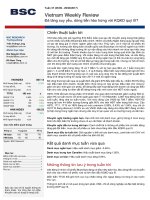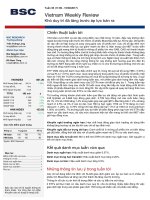Astm e 2641 09 (2017)
Bạn đang xem bản rút gọn của tài liệu. Xem và tải ngay bản đầy đủ của tài liệu tại đây (78.55 KB, 4 trang )
This international standard was developed in accordance with internationally recognized principles on standardization established in the Decision on Principles for the
Development of International Standards, Guides and Recommendations issued by the World Trade Organization Technical Barriers to Trade (TBT) Committee.
Designation: E2641 − 09 (Reapproved 2017)
Standard Practice for
Best Practices for Safe Application of 3D Imaging
Technology1
This standard is issued under the fixed designation E2641; the number immediately following the designation indicates the year of
original adoption or, in the case of revision, the year of last revision. A number in parentheses indicates the year of last reapproval. A
superscript epsilon (´) indicates an editorial change since the last revision or reapproval.
2. Referenced Documents
1. Scope
2.1 ANSI Standard:2
ANSI Z136.1 American National Standard for the Safe Use
of Lasers
2.2 IEC Standard:3
IEC 60825 Safety of Laser Products
2.3 Federal Standards:4
21 CFR 1040.10 Laser Products
21 CFR 1040.11 Specific Purpose Laser Products
OSHA STD 01-05-001-PUB 8-1.7 Guidelines for Laser
Safety and Hazard Assessment
1.1 This practice for the safe application of 3D imaging
technology will focus primarily on the application of specific
technology components common to 3D imaging systems.
When appropriate, reference may be made to existing standards written for said technologies.
1.2 Safety standards relevant to specific industry practices
where the technology may be applied will not be developed
given the very broad potential for application over many
industries. However, general mention and recommendations
will be made to industry specific safety guidelines relevant to
some common applications.
3. Significance and Use
3.1 The overall purpose of standards is to document and
communicate best practices in the successful and consistent
application of 3D imaging technology. When executed
effectively, this leads to an enhanced project performance. This
practice offers a guideline for safe field operational procedures
used in the application of 3D imaging technology.
1.3 This practice covers the following topics:
1.3.1 End-user/operator responsibilities,
1.3.2 Safety plan,
1.3.3 Safety awareness,
1.3.4 Safe application of laser technology common to 3D
imaging systems, and
1.3.5 References to some applicable government regulations.
3.2 Applicability—As 3D imaging technology is applied
across an ever increasing area of application, a set of uniform
standards for their safe application is necessary. This best
practice shall serve as a guideline to both operator and end user
ensuring that necessary and reasonable precautions have been
taken to ensure the safe application of 3D imaging technology.
1.4 This standard does not purport to address all of the
safety concerns, if any, associated with its use. It is the
responsibility of the user of this standard to establish appropriate safety and health practices and determine the applicability of regulatory limitations prior to use.
1.5 This international standard was developed in accordance with internationally recognized principles on standardization established in the Decision on Principles for the
Development of International Standards, Guides and Recommendations issued by the World Trade Organization Technical
Barriers to Trade (TBT) Committee.
4. End-User/Operator Responsibilities
4.1 Safe operation of 3D imaging equipment is the responsibility of both the end user and operator. The end user is
identified as that party using the 3D imaging system deliverable to meet certain project requirements. To the greatest extent
possible, the end user shall ensure that safety practices are
being followed.
2
Available from American National Standards Institute (ANSI), 25 W. 43rd St.,
4th Floor, New York, NY 10036, .
3
Available from International Electrotechnical Commission (IEC), 3 rue de
Varembé, Case postale 131, CH-1211, Geneva 20, Switzerland, .
4
Available from the U.S. Government Printing Office, Superintendent of
Documents, 732 N. Capital St., N.W., Washington, DC 20402-0001.
1
This practice is under the jurisdiction of ASTM Committee E57 on 3D Imaging
Systems and is the direct responsibility of Subcommittee E57.03 on Guidelines.
Current edition approved March 15, 2017. Published April 2017. Originally
approved in 2009. Last previous edition approved in 2009 as E2641–09. DOI:
10.1520/E2641-09R17.
Copyright © ASTM International, 100 Barr Harbor Drive, PO Box C700, West Conshohocken, PA 19428-2959. United States
1
E2641 − 09 (2017)
laser light, the operator should be familiar with the system laser
classification and those safety requirements imposed by such
agencies as the Food and Drug Administration (FDA), Center
for Devices and Radiological Health (CDRH), OSHA, and
others as well as any specific state or local regulations.
4.4.1.3 Finally, the operator should be aware of any hazards
that are present at each job site and understand the relevant safe
operating procedures specific to that site.
4.4.2 The end user may require verification that such
training has occurred.
4.2 3D imaging system operators, identified as the party
operating the 3D imaging system, bear the primary responsibility for its safe application. They should be sufficiently
trained in the safe and correct methods of the 3D imaging
technology operation. In addition to those practices specific to
the technology, the operators shall be aware of site-specific
safety requirements and practices and ensure that these are
being followed consistently.
4.3 Safety Plan:
4.3.1 Given the mutual responsibility for safety by the end
user and the operator, a written safety plan designed for a
specific 3D imaging project is strongly recommended. Development of such a plan should be the mutual responsibility of
both the end user and the operator with each contributing their
respective knowledge, training, and experience. Any safety
plan should encompass practices designed to ensure the safe
application of the 3D imaging system while meeting the safety
requirements relevant to a specific site.
4.3.2 The safety plan establishes a common understanding
and awareness of safety by both the end user and the operator.
Typically, a safety plan should address, but is not limited to:
4.3.2.1 Safe application of 3D imaging system components
within the context of government regulations or industry
specific regulations, or both. Typically, such regulations focus
on the light-emitting components of the imaging system. The
safety plan should include a description of and procedures
taken to ensure that the system operation will conform with
site-established safety protocols and, at a minimum, regulations such as those of the Occupational Health and Safety
Administration (OSHA) (see standards in Section 1.3.3). Issues
such as laser emission impact on existing operations and
personnel with respect to eye safety, possible distraction by
visible beams, and so forth, with a corresponding plan addressing area control would become a key component of the daily
job hazard analysis.
4.3.2.2 The safety plan shall include site-specific safety
rules, regulations, disruption of operation notices, and so forth,
covering various operational scenarios. Such scenarios typically include transportation of equipment, placement of reference targets, use of ladders or scaffolding, or both, use of any
elevated system platform, use of personal protection
equipment, and so forth.
4.3.2.3 Site-specific hazards such as confined spaces, vehicle or pedestrian traffic, or both, explosion-endangered areas,
and so forth and the safe application of equipment within the
constraints of said hazards should be addressed in the safety
plan.
4.5 Operator Awareness—A safety plan specific to the site is
the recommended practice for ensuring safe operation to the
greatest extent possible. The safety plan should possess a
mechanism promoting and verifying operator awareness of the
safety plan and the requirements stated therein and end user
awareness that such procedures are being followed. This may
include a daily checklist designed to ensure safety measures are
followed in accordance with the safety plan throughout the
project. Such a checklist should be designed to reinforce
adherence to the safety plan and include areas for incident
reports and general comments.
5. Safe Application of Laser Technology
5.1 3D imaging systems are comprised of several components typically including a power supply, processing computer,
laser imaging detection and ranging (LiDAR) scanner, and
often, a camera. A transmitting laser is often a key component
in a 3D imaging system and is often the principal safety
concern when using a 3D imaging system.
5.2 The manufacturer of 3D imaging equipment using laser
technology is responsible for its appropriate laser classification.
5.3 The operator is responsible for applying the technology
safely per the requirements of the laser classification as defined
by applicable government agencies such as CDRH, OSHA, and
so forth.
5.4 Laser Hazard Classification:
5.4.1 All laser systems manufactured or purchased by a
company are classified with respect to their performance
characteristics and are labeled accordingly. Different levels of
safety precautions are applicable to each classification. For this
reason, the safe use of 3D imaging systems begins with
understanding the laser hazard classification of the instrument
and appropriate safety measures required. This knowledge
facilitates development of the project safety plan and implementation of correct precautionary measures while using the
3D imaging system.
5.4.2 The end user and operator should be familiar with the
applicable standards regarding laser classification and the
corresponding safeguards required for operation. See the Bibliography for further information.
4.4 Operator Training:
4.4.1 Operator training is a key component of any safety
plan. In applying 3D imaging technology to a specific project,
operators should be trained in three specific areas.
4.4.1.1 The first is the safe application of the 3D imaging
equipment itself. Specifically, the operator shall demonstrate
familiarity with safety requirements of each component of the
3D imaging system.
4.4.1.2 Secondly, the operator bears the primary responsibility for the awareness of the general safety requirements of
the 3D imaging system. For example, should the system emit
5.5 Applicable Local Laws—In addition to law and regulations issued by government agencies and regulating bodies,
there often exist laws or regulations, or both, issued by state or
local agencies regarding the emission of laser light. The
operator should be aware of any relevant local law(s) or
2
E2641 − 09 (2017)
regulations, or both, and their relevance to the application of
the operator’s specific 3D imaging system.
6. Keywords
6.1 laser; safety plan; scan; 3D imaging technology
APPENDIXES
X1. GLOSSARY OF LASER TERMS
NOTE X1.1—The glossary of laser terms will be supplied at a later date.
X2. EXAMPLES OF SOME CURRENT STATE LASER REGULATIONS
X2.1 See Table X1.1 for examples of some (not all inclusive) current state laser regulations.
TABLE X2.1 Examples of Some Current State Laser Regulations
State
Department
Alaska
ArizonaA
Arkansas
New York
Pennsylvania
Texas
Environmental Conservation
Radiation Regulatory Agency
Division of Radiation Control &
Emergency Management
Department of Health &
Rehabilitative Services
Department of Public Health
Department of Nuclear Safety
Department of Public Health
Health & Environmental
Services
Department of Labor
Environmental Resources
Department of Health
Washington
Labor & Industry
FloridaA
Georgia
Illinois
Massachusetts
Montana
Regulation
Title 18, Article 7
Chapter 3
Act 460
Non-Ionizing Chapter:
10D-89
Chapter: 290-5-27
Chapter: 1111⁄2
105 CMR 21
92-003
Code Rule 50
Chapter: 203, Title 25
Radiation Control Act
Parts 50, 60, 70
Chapter 296-62-WAC
A
Using the Conference of Radiation Control Program Directors (CRCPD) “model
state” laser standard as basis.
BIBLIOGRAPHY
Sample Safety Plans:
/> />(5) Laser Institute of America, Orlando, FL,
/>(6) U.S. Food and Drug Administration, Center for Devices and Radiologial Health, HHS Publication FDA 83-8220, “Sugggested State
Regulations for Control of Radiation,” Vol II Non-ionizing Radiation
LASERS, 1982,
/>
(1) />
Laser Information:
(2) ANSI Z-136.1, Standard for Safe Use of Lasers, American National Standards Institute, New York, 1986.
(3) ANSI Z-136.6, Standard for Safe Use of Lasers Outdoors, American National Standards Institute New York, 2005.
(4) 29 CFR 1926.54, Non-Ionizing Radiation in Construction Industry,
OSHA Technical Manual, Section III, Chapter 6, Laser Hazards,
Occupational Safety and Health Administration,
3
E2641 − 09 (2017)
ASTM International takes no position respecting the validity of any patent rights asserted in connection with any item mentioned
in this standard. Users of this standard are expressly advised that determination of the validity of any such patent rights, and the risk
of infringement of such rights, are entirely their own responsibility.
This standard is subject to revision at any time by the responsible technical committee and must be reviewed every five years and
if not revised, either reapproved or withdrawn. Your comments are invited either for revision of this standard or for additional standards
and should be addressed to ASTM International Headquarters. Your comments will receive careful consideration at a meeting of the
responsible technical committee, which you may attend. If you feel that your comments have not received a fair hearing you should
make your views known to the ASTM Committee on Standards, at the address shown below.
This standard is copyrighted by ASTM International, 100 Barr Harbor Drive, PO Box C700, West Conshohocken, PA 19428-2959,
United States. Individual reprints (single or multiple copies) of this standard may be obtained by contacting ASTM at the above
address or at 610-832-9585 (phone), 610-832-9555 (fax), or (e-mail); or through the ASTM website
(www.astm.org). Permission rights to photocopy the standard may also be secured from the Copyright Clearance Center, 222
Rosewood Drive, Danvers, MA 01923, Tel: (978) 646-2600; />
4
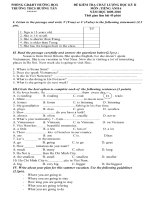

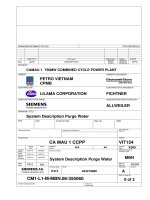


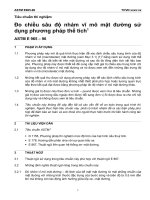

![TIENLEN CORPORATION - Tập đoàn Thép Tiến Lên | Quan he co dong | Thong bao | Cac khoan vay tu ngay 31 07 2017 den ngay 24 09 2017 []](https://media.store123doc.com/images/document/2017_10/19/medium_qsq1508422764.jpg)
